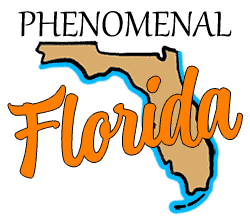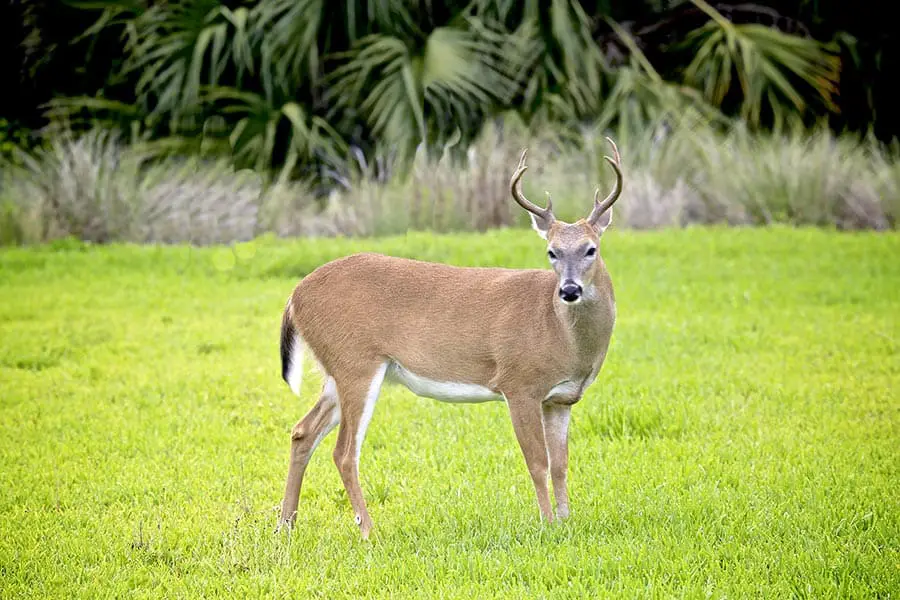
Most everybody likes to see wildlife, especially graceful animals like deer. With their long legs, cute faces, and gentle nature, deer are fun animals to spot when you’re out enjoying a walk or a hike. But are there any deer in Florida?
Florida has a healthy population of deer, primarily white-tailed deer. One can also find the Sambar deer on St. Vincent Island in the Florida panhandle near Apalachicola. In the lower Florida Keys, there is a population of Key deer, a smaller species of deer that live only in the Keys.
So what is the difference between these types of deer? What is the deer population in Florida – are they overpopulated or thriving in harmony with the ecosystem? Are deer protected in Florida, or is there a hunting season? Read on to discover more.
Deer – The Cuter Side of Florida’s Wildlife
Florida’s wildlife has a reputation for being a bit on the wilder side. Alligators, crocodiles, snakes, spiders, bears… many of the creatures one thinks of in Florida are rather hazardous and decidedly not cuddly. However, the Sunshine State is home to some beautiful and gentle animals as well – including a variety of deer.
The three species of deer one can find in Florida are the white-tailed deer, the Sambar deer, and of course, the Key deer. Each of these species fills a unique ecological niche in their environment.
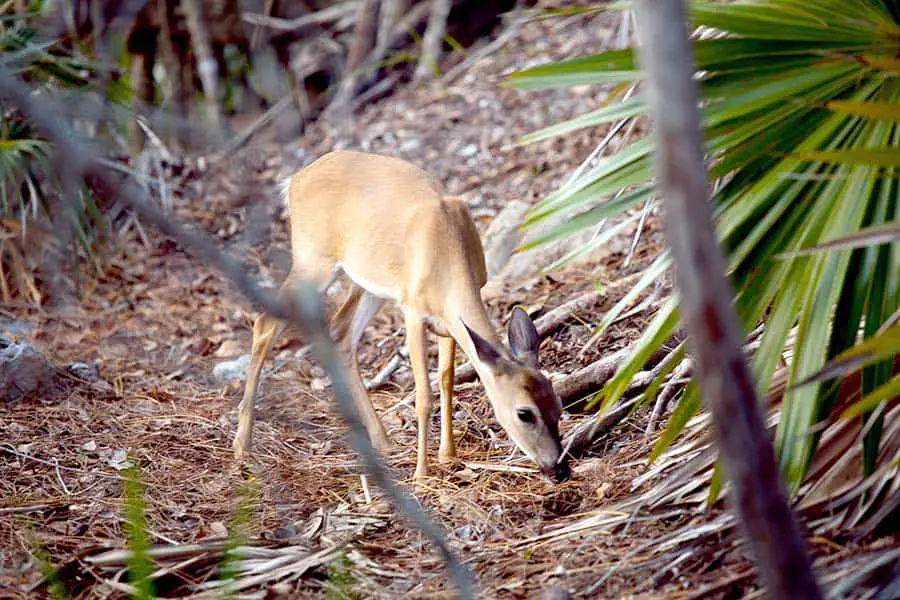
The white-tailed deer are commonly seen in the Florida peninsula, and the panhandle: hikers, drivers on rural roads, and people camping or living in rural Florida are likely to encounter white-tailed deer. The Sambar deer and Key deer are found in smaller ranges; Sambar deer are only found on St. Vincent Island, and Key deer are only found in the Keys.
White-tailed deer are native to Florida. Their name aptly comes from the distinctive patch of white fur that decorates their tail. This white patch is used as a signal to other deer: when a deer detects danger, it flares the white patch on its tail before taking evasive action. These deer will also sometimes snort and stomp to warn their peers in the presence of something they deem hazardous.
Are white-tailed deer in Florida smaller than in other states? The answer really depends on the habitat. The Florida Fish and Wildlife Conservation Commission says that the average white-tailed buck in Florida weighs in at around 115 pounds, but they can grow closer to 200 pounds in North Florida.
This variation in size is related to local conditions: forage is different across the state, and deer in South Florida don’t need to worry about any kind of winter period. And this is especially true for the Key deer.
The Key deer is a smaller subspecies of the white-tailed deer and is found only in the lower Florida Keys, with the bulk of their population concentrated on Big Pine Key. These deer are much smaller than their white-tailed cousins, growing only to about 80 pounds and about 30 inches at the shoulder – they are about the size of a large dog.
On the other end of the spectrum is the Sambar deer. First introduced to Florida in 1908, these deer reside only on St. Vincent Island in the Florida panhandle. They are much larger than other deer, sometimes reaching weights of more than 400 pounds! These deer are popular with hunters, and both Florida residents and non-residents can apply for permits to hunt the Sambar deer with bows.
Phenomenal Florida Fun Fact: Sambar deer are actually native to Southeast Asia. In fact, these deer are favorite targets of Bengal Tigers, who can actually mimic the cries of these deer during the hunt.
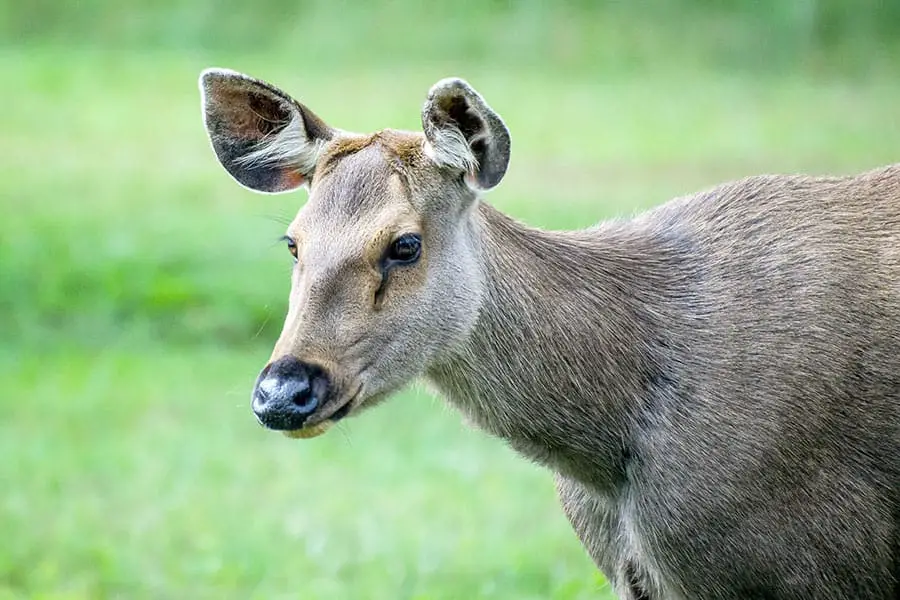
What is the Deer Population in Florida?
An exact headcount is impossible, but a 2019 estimate placed the population of white-tailed deer in Florida at about 542,000 deer. This figure is a decline from previous years, which is likely a result of a combination of pressures.
The dreadful and invasive Burmese python preys on deer and has seriously impacted deer populations in south Florida; the continuous development of deer habitat also applies pressure to the species. However, the white-tailed deer is not considered endangered or threatened in Florida.
Other Posts of Interest
- Is It Illegal To Take Shells From Florida Beaches?
- What Is The Most Visited Beach In Florida?
- Can You Find Sea Glass In Florida?
- Is Daytona Speedway Asphalt Or Concrete?
Are Deer Overpopulated in Florida?
Deer in Florida are not considered overpopulated. Many Floridians enjoy hunting deer during the appropriate season, which helps keep the population in check. The previously mentioned pressures of invasive predators and overdevelopment are affecting the overall deer population, but current population estimates show a healthy deer population in the state.
Where is the Highest Deer Population in Florida?
While deer are everywhere in Florida, the Florida Panhandle has the largest overall population in terms of both number and size. In addition, the rural nature of the panhandle and its proximity to herds in places like Alabama and Georgia make it a great place for deer to roam.
However, heavily developed regions of the state, such as Tampa Bay, Miami, Orlando, and Jacksonville, have lower overall deer populations for self-explanatory reasons.
Do Florida Deer Shed Antlers?
Deer in Florida do shed their antlers. Usually, antlers are shed during the winter months and begin to grow back as the days become longer. Antler shedding in many areas coincides with the end of the rut or the deer’s mating season.
Florida’s mild climate means that deer have a longer season in which to mate, so the rhythms of the herd are not exactly as one might expect in a different location.
Are There Deer in the Florida Keys?
Yes, as I mentioned earlier in this post, the Florida Keys are home to a species of deer known as the Key deer. Key deer have been documented as far back as the 1550s when a shipwrecked Spanish sailor noted their presence in the keys.
It is believed that the Key deer’s presence in the region dates back to a period known as the Wisconsin glaciation, during which time the deer were able to migrate to the keys on foot. Key deer are capable swimmers and will often swim from one key to the next when foraging for food.
Are Key Deer Endangered?
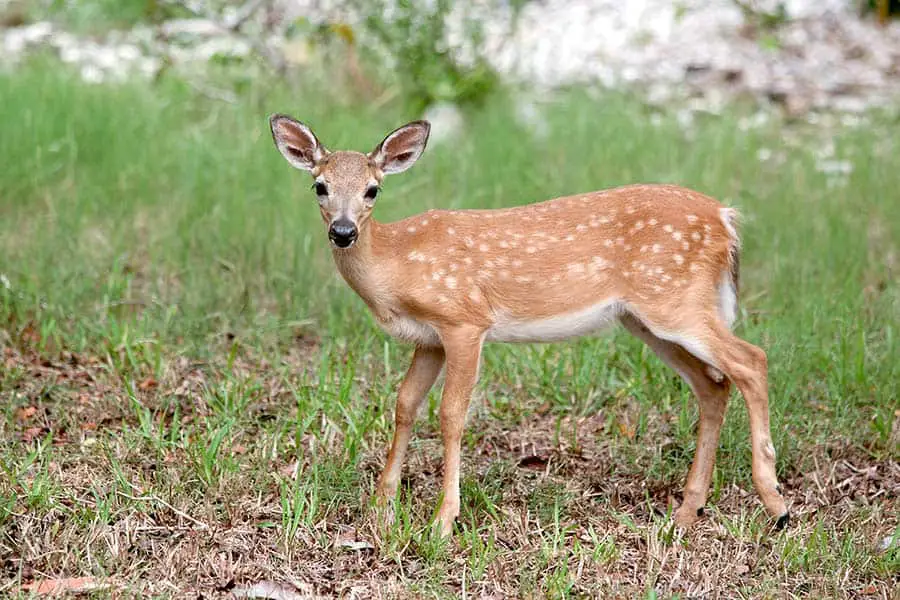
Key deer were almost hunted to extinction. Then, during the 1940s, a combination of hunting and habitat destruction pushed the species to the brink: only about 50 individual Key deer remained. Finally, the state of Florida intervened, establishing the National Key Deer Refuge, building roadside fences to mitigate car vs. deer collisions, and increasing enforcement of hunting laws in the lower keys.
These steps, plus protection from the Federal Endangered Species Act, have pulled the species back from the edge of extinction. According to the Florida Fish and Wildlife Conservation Commission, it is estimated that there are about 800 Key deer in the wild.
However, Key deer are still listed as endangered. The development and alteration of their habitat by human beings continue to stress these adorable deer. Their docile nature, regular contact with humans, and feeding of the deer by tourists and locals alike have led the Key deer to lose their fear of humans. Unfortunately, this lack of fear leads to an increase in inappropriate feeding and car vs. deer collisions that continues to threaten the Key deer.
Can You Pet or Feed the Key Deer?
No, as cute and docile as Key deer are, you should not feed or pet the deer. Regular contact with humans can lead to behavioral changes, dependence on humans for food, and exposure to novel pathogens. Like any other beast in the wild, the Key deer are best enjoyed from a distance, observed, and admired without being harassed or touched.
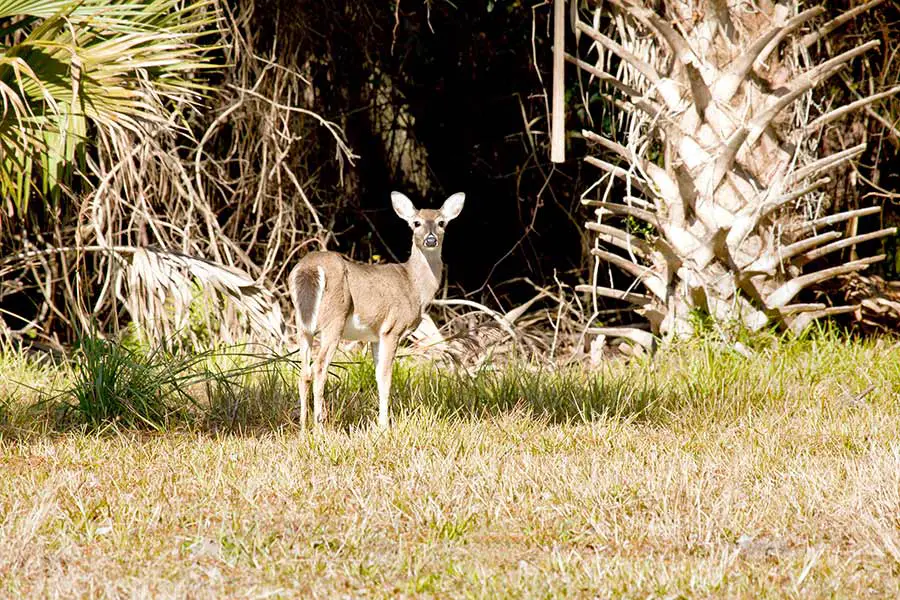
Are Deer Protected in Florida?
White-tailed deer and Sambar deer are not protected in Florida. As a result, white-tailed deer are popular prey animals during hunting season. Sambar deer are also popular among hunters, although they are hunted with bows, and permits are less readily available than hunting permits for regular deer.
While these deer are not protected, Key deer are protected. As cute and docile as Key deer are, do not approach, feed, or otherwise harass Key deer. You can face criminal charges if you injure, harass, or kill Key deer. The Florida Fish and Wildlife Commission — whose officers are sworn law enforcement officers with arrest power — does actively patrol the Keys. Enjoy Key deer from a distance with your binoculars or your camera.
Hanging On for Deer Life
Florida’s deer population is healthy and thriving. Despite recent declines caused by the development of habitats and predation by invasive species like Burmese pythons, white-tailed deer remain a staple of Florida wildlife. It’s not unusual to see white-tailed deer grazing in a field as the sun sets or to come across them while out hiking in the woods.
Likewise, Sambar deer thrive in their island refuge, living a good life and providing a spectacle for visitors to the wildlife refuge with their imposing size and distinctive looks.
While they have faced challenges, Key deer also thrive in Florida. They have learned to survive in the often harsh wilderness of the Keys, swimming from key to key and finding forage and freshwater wherever they can. Much like the average Floridian, deer are hardy, strong survivors. Even as times change and ecosystems evolve, deer continue to thrive in the Sunshine State.
